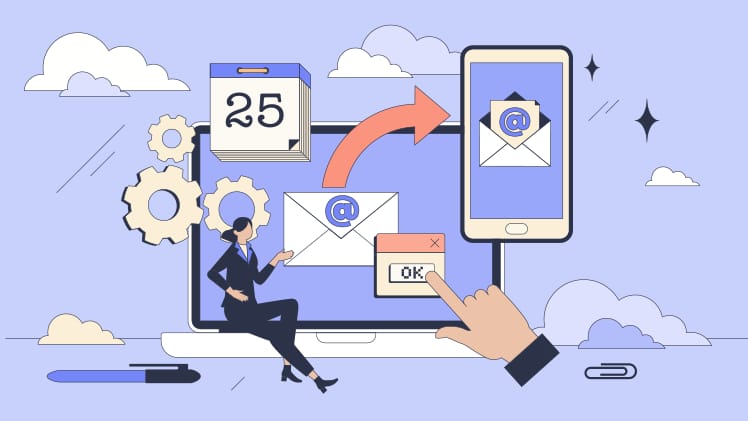For businesses operating in B2B commerce, accounts receivable (AR) is more than a back-office function—it’s a lifeline to cash flow, client trust, and strategic growth. Yet, many organizations still rely on manual AR processes, believing that they should not change what is not broken.
But are manual methods truly efficient? Let’s explore:
The Manual Struggle
Manual AR workflows are relics of an era when spreadsheets were cutting-edge and “client relationships” meant hand-delivered invoices. Today, they’re a liability.
- Speed vs. Scale: B2B deals often involve complex contracts, multi-tiered approvals, and high transaction volumes – challenges that manual processes struggle to keep up with. A single late invoice can cascade into delayed payments, strained vendor relationships, and missed opportunities.
- Error Proliferation: Human error is unavoidable. A misplaced decimal, a missed follow-up, or a misfiled document can cost thousands. For B2B firms with tight margins, these errors erode profitability.
- Data Blindness: Manual systems offer no visibility into payment trends, aging receivables, or client payment behaviors. Without actionable insights, businesses operate in the dark—unable to negotiate terms, prioritize collections, or forecast cash flow.
The Automation Advantage: Precision, Profit, and Progress
Accounts receivable automation isn’t just a convenience—it’s a strategic imperative. By streamlining repetitive tasks, reducing errors, and providing actionable insights, automation transforms AR from a cost center into a profit driver. Here’s how:
1. Unmatched Efficiency: Speed and Scalability
Manual AR processes are slow, error-prone, and unsustainable at scale. Consider the numbers:
- Invoice Processing: Automation reduces invoice processing time by up to 70%, cutting costs and accelerating cash flow.
- Payment Reminders: Automated reminders ensure timely payments, reducing Days Sales Outstanding (DSO) by up to 30%.
- Reconciliation: AI-driven systems auto-apply payments and resolve discrepancies in real-time, eliminating manual reconciliation.
For B2B firms with high transaction volumes, these efficiencies translate to millions in saved labor costs and improved liquidity. Imagine a multinational corporation processing 10,000 invoices monthly—automation could free up 20+ FTEs to focus on strategic tasks.
2. Flawless Accuracy: Error Reduction and Compliance
Human error is the biggest weakness of manual accounts receivable processes. A single misplaced decimal or misfiled document can cost thousands. Automation eliminates these risks:
- Invoice Accuracy: Automated systems validate data before invoices are sent, ensuring 99.9% accuracy.
- Compliance: Built-in tax calculators and audit trails ensure adherence to regulations like GDPR and IFRS, reducing penalties.
- Dispute Resolution: AI analyzes payment histories to predict and resolve disputes before they escalate, minimizing bad debt.
For B2B businesses operating in regulated industries or multiple jurisdictions, compliance is non-negotiable. Automation simplifies tax adjustments, currency conversions, and reporting, ensuring global consistency.
3. Data-Driven Decisions: Insights for Growth
Manual AR provides no visibility into payment trends or client behavior. Automation, however, turns raw data into strategic intelligence:
- Predictive Analytics: Machine learning forecasts cash flow gaps, enabling proactive adjustments to inventory or credit policies.
- Client Insights: Dashboards highlight which clients habitually delay payments, allowing tailored follow-up strategies.
- Performance Metrics: Real-time KPIs like DSO, cash flow cycle time, and invoice processing speed help optimize operations.
4. Enhanced Customer Relationships: Convenience and Trust
In B2B, relationships are everything. Automation enhances client experiences without sacrificing personalization:
- Self-Service Portals: Clients access invoices, track payments, and resolve disputes 24/7, boosting satisfaction.
- Personalized Communication: Automated reminders are polite and consistent, avoiding the awkwardness of manual follow-ups.
- Faster Onboarding: AI-driven credit checks reduce onboarding time from days to hours, improving client retention.
5. Scalability and Future-Proofing
As your business grows, manual AR becomes a bottleneck. Automation scales seamlessly:
- Volume Flexibility: Process 100 or 10,000 invoices with the same effort.
- Global Expansion: Manage multi-currency, multi-tax invoices effortlessly.
- Integration: Seamlessly connect with ERP systems like SAP or Oracle for unified workflows.
The Myths That Hold Businesses Back In Switching to AR Automation
“Automation is too expensive.”
Many businesses assume automation requires a hefty upfront investment, but cloud-based AR platforms start as low as $100/month. These solutions scale with your needs, eliminating the financial burden of heavy infrastructure costs. The real question isn’t whether automation is too expensive—it’s whether your manual processes are costing you more. Studies show that automation leads to faster payments, reduced labor costs, and fewer errors, delivering ROI that often pays for itself in just a few months.
“Clients prefer human interaction.”
While personalized service is crucial for relationship management, it’s not always necessary for routine tasks. Many B2B buyers prefer self-service options for payments and invoice inquiries, as they offer instant access to information without waiting for human assistance. Automating these touchpoints improves the customer experience by providing 24/7 access to invoices, payment portals, and dispute resolution—allowing your team to focus on high-value engagements that build stronger client relationships.
“Our processes are too unique for automation.”
A common misconception is that automation follows a one-size-fits-all approach. However, modern AR solutions offer configurable workflows, tiered approval structures, and seamless ERP integrations that adapt to your business needs. Whether you require industry-specific compliance checks, custom approval paths, or specialized invoice matching, today’s automation tools provide flexibility without disrupting your operations. Instead of forcing your business to fit into rigid software, advanced AR solutions mold to your existing processes—ensuring efficiency without compromise.
The Verdict: Choosing the Right Automation Wins—Every Time
Automation is key to modernizing accounts receivable, but choosing the right solution is just as important. While manual methods may feel familiar, they come with high costs, errors, and inefficiencies that slow down B2B operations. However, not all automation tools deliver the same value. The right Account Receivable Automation solution should offer precision, scalability, and data-driven insights to turn AR into a strategic advantage. By selecting the right automation tool, businesses can streamline processes, reduce costs, and drive long-term growth.
The choice is clear: Evolve or stagnate. Are you ready to turn your AR process from a liability into a competitive advantage? The future isn’t coming—it’s here.



































